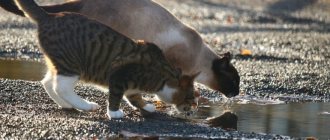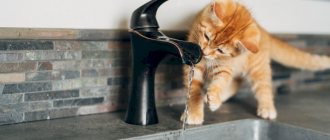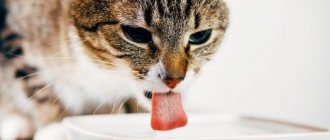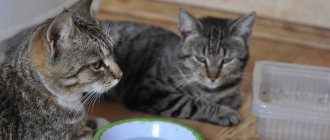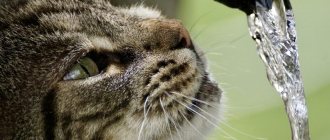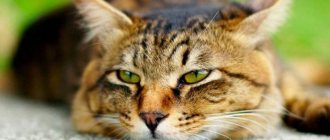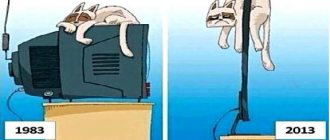The appearance of a small kitten in the house is a big responsibility for the owner. It is necessary to provide the animal with proper nutrition and proper care. Creating comfortable conditions includes mandatory monitoring of any even the slightest changes in health.
If a cat refuses food and water, this is a sign that not everything is fine with the pet. It is necessary to understand how much fluid an animal consumes per day is normal, and in what cases it is necessary to seek help from a veterinarian. Prolonged dehydration negatively affects the functioning of the entire body and each cell in particular.
How to tell if your cat is not drinking enough water
An acute lack of fluid in the body at the cellular level leads to the fact that the cellular structures shrink, the blood and lymph circulating throughout the body become much thicker. Oxygen does not penetrate the cells in the required quantity, oxygen starvation occurs. Against the background of dehydration and serious disorders, pathological changes occur in the intestinal tract, ureter, and respiratory tract. The pet becomes lethargic, the coat becomes dull, and the animal’s state is apathetic.
It is necessary to understand that young animals in good health can be without drinking water for a long time - for 3-4 days. The older the animal is or has a history of a number of chronic diseases, the higher the risk of pathological changes when dehydration occurs. The body's reserves are depleted, which provokes severe problems, which ultimately leads to death.
Unlike dogs, cats are not particularly fond of drinking water, especially in large quantities. However, their need for clean drinking water is significant. Cats need much less fluid per day than dogs or other animals, but without water the body cannot function normally.
As a result of the fact that water is an important component of both cellular structures and intercellular space, the biological properties and structures of elements are determined, influencing the process of thermoregulation of the body and the transfer of useful components.
Regular loss of fluid occurs in the body along with salivary fluid, urine and feces. In the absence of replenishment, serious complications arise that provoke problems in the functioning of the entire body.
If a cat refuses to drink on its own, the risk of dehydration increases. Against the background of dehydration of the whole body, internal organs begin to suffer, and first of all, the central brain. All metabolic processes in cells are disrupted.
Scientists have proven that with a percentage loss of body fluid of up to 10%, there is a high risk of developing irreversible processes in the tissue structures of the body. If the percentage of fluid loss exceeds 15-20%, the animal may die. Dangerous conditions that lead to a sharp development of dehydration are stool disorders (profuse diarrhea), persistent vomiting, extensive hemorrhages (especially internal bleeding) against the background of injuries to internal organs, edematous conditions. In addition to fluid, the body loses a large amount of microelements, vitamins and other nutrients.
Such conditions and changes in the body are difficult to normalize. As soon as the owner notices a problem in the pet’s health, it is recommended to immediately contact a veterinary clinic for help. Only in a hospital hospital setting is it possible to carry out infusions of saline solutions, glucose or other substances that maintain the body’s water balance at the required level, avoiding the development of complications.
Special liquids for cats
What special liquids can be used to treat cats?
It is possible that the veterinarian will prescribe special liquids to the cat, which are often used to replenish the loss of certain chemicals, which often happens after diarrhea or vomiting. In this case, you can use (depending on what the veterinarian says) ready-made powders, which can be simply diluted and given to the cat with such a solution, or you can prepare the solution yourself. To do this, take two liters of water, one teaspoon of salt and one dessert spoon of glucose.
The cat is sick: what should I give her to drink?
If you find an error, please select a piece of text and press Ctrl+Enter.
When is this the norm?
Experienced cat owners know the daily requirement of a pet's body for clean water. On average, the daily volume of fluid consumed is calculated individually and is about 60 ml per 1 kg of the cat’s live weight. If we judge the dry matter - 2 ml of liquid per 1 g of dry part. It is worth noting that not all cats need to drink a strictly regulated amount of liquid. After all, it is necessary to take into account a number of factors that influence not only the loss of fluid, but also the need to replenish it. The main factors are:
- cat nutrition - wet or dry granulated food; the animal eats, drinks milk or soups;
- climate and weather conditions - summer time (heat outside), cold time (dry indoor air);
- age characteristics and breed - increased activity of the pet or, on the contrary, apathy by nature.
At the same time, we must not forget that any domestic cat, even if it does not show much interest in water, should have its own drinking bowl. The water must be changed regularly and ensure that it does not have any foreign odors or impurities in its composition.
Some pet owners give their pets distilled water, believing that it is better purified. Distilled water does not contain microelements and long-term consumption of such liquid provokes disturbances in various body systems. The bowl from which your pet drinks water must be clean, preferably made of ceramic or glass. It is not recommended to use plastic containers.
How much water should a cat consume per day?
Again, keep in mind that the cat will obtain water from its diet as well as through drinking water. The cat should drink approximately 60 ml of water per kilogram of body weight. My cat drinks a lot of water:
Increased water intake is medically known as polydipsia and should be observed. Kidney disease, diabetes, pyometra (uterine infection, liver disease, and hyperthyroidism) are diseases that can be caused by a lack of water or a sudden increase in it.
It is always important to have your cat checked by a veterinarian if you notice that she is drinking more water. Increased water intake usually goes hand in hand with increased urination (polyuria/polydipsia).
Flavored ice cubes
You can make ice cubes from chicken or beef broth and add them to your cat's water bowl.
To make meat flavored ice cubes, you will need:
- 1 cup broth from minced meat or chicken
- 2 glasses of water.
Add all ingredients to the pan, bring to a boil and simmer for 8-10 minutes. Strain the water into an ice cube tray.
Possible diseases
Having noticed that the cat refuses to eat or drink water, the owner should not ignore this condition. Such signs may indicate the development of serious diseases, especially when combined with other symptoms - eruption of gastric contents, diarrhea, increased fatigue and apathy, discharge of mucous exudate from the nasal passages and eyes, increased body temperature.
It is noted that forcing a cat to drink water is not advisable. It is better to use a trick by placing several containers of water around the house so that the cat can drink water when she wants it. If the animal does not want to drink water, you can try to buy a special drinking fountain that will interest the cat. Under normal conditions, a cat may not feel thirsty and not drink due to the following factors:
- if the animal receives natural food or canned ready-made food, it means that the body receives the proper amount of fluid;
- the pet’s consumption of fresh kefirs, fermented baked milk, broths means that the water and electrolyte balance is normal;
- Kittens fed on mother cat's milk do not need additional water.
If a cat refuses water and exhibits additional symptoms such as malaise, weakness, vomiting or other signs, then the cause of the abnormal refusal is pathology. The following conditions can provoke an abnormal refusal to drink water in a cat:
- inflammatory pathologies in the oral cavity (damage to teeth, gums - gingivitis, stomatitis, periodontitis, tartar);
- diseases of the digestive tract (gastritis, duodenitis, ulcerative pathologies, inflammation of the pancreas, diseases of the hepatobiliary system);
- malignant neoplasms in the body, especially in the oral cavity;
- infectious diseases of the respiratory tract affecting the throat and pharynx, accompanied by ulcerations;
- extensive blood loss causing severe weakness;
- various pathologies of the renal system.
If you notice a deterioration in your pet’s condition, it is not recommended to self-medicate. As a rule, diseases in the body do not occur with the presence of one symptom.
This is a whole set of signs indicating the development of a pathological process. It is necessary to seek help from a veterinary clinic as soon as possible, bring your pet to an appointment, or consult a doctor by telephone.
How to determine if your cat drinks enough fluid per day
Animals have the same problems as humans when they don't get enough fluids. Cats may not get the moisture they need for a variety of reasons, but owners should closely monitor their pet's health.
Be sure to read:
How to reconcile cats living in the same apartment: several ways to make pets friends
The following signs may indicate your pet's condition:
- Skin elasticity . Your pet's skin becomes dry and stiff if he doesn't drink enough fluids. Normal dermis quickly regains its shape if you grab the cat's scruff and pull.
- Condition of the coat. It is worth sounding the alarm when the cat’s fur loses its shine and begins to fall out. If the animal does not have parasites or allergies to the selected diet, then the problem may lie precisely in the lack of moisture. When a pet's coat is shiny, it makes it clear that its health is not in danger.
- Physical activity. Without the necessary moisture, the cat becomes inactive, reacts sluggishly to calls, and does not want to play.
- Frequency of urination . If an animal urinates less than 2 times a day, this is a sign of ill health.
The water doesn't taste good!
If your kitten doesn't drink water, he may not like the taste of it. The water should be clean, fresh, at room temperature, without any foreign taste. Cats have a well-developed sense of smell; if they sense an unpleasant or incomprehensible odor, they will not lap up the liquid. It is best to offer settled, filtered tap or bottled water.
The baby, recently separated from his mother, does not yet know how to drink, so at first the owner will have to teach him to lap up liquid from a bowl. They do it this way: they run a wet finger over the nose and mouth - the cat reflexively licks itself and gradually gets used to the new taste. You can drop some water on your nose from a pipette or syringe.
It is necessary to offer to drink cool water more often after outdoor games, when the pet is thirsty. Some owners add a little water to the milk so that the body receives the required amount of fluid.
Over time, the animal will understand that water is tasty and will begin to independently look for it in the house. The pet can drink from the tap, climb into the sink or bathtub, or from the aquarium. This is wrong, the baby must be taught to use a drinking bowl. Bowls with water are placed where the cat is most often. The kitten will come across them and perhaps choose one of them as his favorite.
